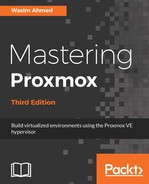RADOS Block Device (RBD) storage is provided by the Ceph distributed storage system. It is the most complex storage system, which requires multiple nodes to be set up. By design, Ceph is a distributed storage system and can be spanned over several dozen nodes. RBD storage can only store .raw image formats. To expand a Ceph cluster, simply add a hard drive or a node and let Ceph know about the new addition. Ceph will automatically rebalance data to accommodate the new hard drive or node. Ceph can be scaled to several petabytes or more. Ceph also allows multiple pool creations for different disk drives. For example, we can store database servers' VM images on an SSD-driven pool and back up server images on a slower-spinning drive pool. Ceph is the recommended storage system for medium-to-large cluster environments due to its resilience against data loss and the simplicity of storage expandability.
As of Proxmox VE Version 4.1, the Ceph server has been integrated into Proxmox to coexist on the same node. The ability to manage Ceph clusters through the Proxmox GUI has also been added. Later in this chapter, we will learn how to create a Ceph cluster and integrate it with Proxmox. Ceph is a truly enterprise storage solution with a learning curve. Once the mechanics of Ceph are understood, it is also one of the easiest to maintain. To know more about Ceph storage, refer to http://ceph.com/docs/master/start/intro/. There's more to come in Chapter 5, Installing and Configuring Ceph.
